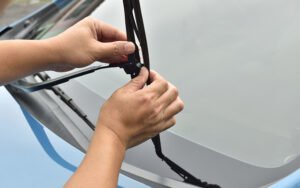Your car’s air filter might be small, but it plays a massive role in keeping your engine healthy. By trapping dust, dirt, pollen, and other airborne debris, it ensures that only clean air enters the combustion chamber. A clogged or dirty air filter forces the engine to work harder, slashing fuel efficiency, boosting harmful emissions, and sapping performance. Over time, it can even lead to costly engine damage. The good news? Checking and replacing your air filter is one of the easiest DIY maintenance tasks you can tackle—no mechanic required. This detailed guide walks you through every step with clear, non-technical instructions, empowering you to keep your car running smoothly while saving time and money.
Step 1: Gather Your Tools and Materials
Preparation is key to a seamless air filter replacement. Having everything ready beforehand avoids interruptions and ensures you’re equipped for the job.
1.1 Tools and Materials You Will Need
-
- A New Air Filter: Not all filters are the same—your car requires a specific size and type. Check your owner’s manual or use an online parts lookup tool (enter your vehicle’s make, model, and year) to get the right one. Filters can be flat panels, cylindrical, or conical, depending on your engine.
-
- A Screwdriver (If Required): Some air filter housings are secured with Phillips or flathead screws. A small, multi-tip screwdriver is usually sufficient—check your manual to confirm.
-
- A Shop Towel or Clean Rag: Dust and grime can accumulate inside the housing. A towel lets you wipe it clean, protecting the new filter.
-
- A Vacuum Cleaner (Optional): For heavy debris, a handheld vacuum or shop vac makes quick work of cleaning the housing interior.
1.2 Why Preparation Matters
Starting with the right tools and a compatible filter prevents headaches—like realizing mid-task that your new filter doesn’t fit or that you can’t open the housing. A few minutes of prep saves time and ensures success.
Step 2: Locate the Air Filter Housing
The air filter lives inside a protective box in your engine bay, connected to the intake system that feeds air to the engine. Finding it is the first hands-on step.
2.1 How to Find the Air Filter Housing
-
- Open the Hood: Park on a level surface, turn off the engine, and pop the hood. Secure it with the prop rod or latch to keep it steady.
-
- Spot the Box: Look for a black plastic housing—usually rectangular or cylindrical—with metal clips, screws, or bolts. It’s often positioned near the top or side of the engine, linked to a wide tube (the air intake) leading toward the throttle body.
-
- Use Your Manual: If it’s not obvious, your owner’s manual has a diagram or description. In some cars, it’s tucked near the fender or behind the battery.
2.2 What to Expect
The housing is designed for easy access since air filters need regular replacement. It might be labeled “Air Filter” or have an intake tube snaking out, making it stand out among other components.
Step 3: Open the Air Filter Housing
With the housing located, you’ll need to open it to access the filter. This step varies slightly depending on your car’s design.
3.1 How to Open the Housing
-
- Identify the Fasteners: Check how the lid is secured:
-
- Clips: Plastic or metal clips hold the lid snugly. Gently press or pull them outward (sometimes upward) to release—don’t force them, as they can snap.
-
- Screws/Bolts: Use the appropriate screwdriver to loosen them counterclockwise. Keep screws in a safe spot (e.g., a magnetic tray or cup) to avoid losing them in the engine bay.
-
- Identify the Fasteners: Check how the lid is secured:
-
- Lift the Cover: Once unfastened, lift the lid carefully. It might be attached to the intake tube, so wiggle it free if needed. Set it aside on a clean surface.
3.2 Tips for Success
-
- Work gently—plastic housings can crack if you pry too hard.
-
- Note the lid’s orientation (e.g., which side has clips) so reassembly is straightforward.
-
- If it resists, double-check for hidden fasteners—some designs are sneaky.
Step 4: Inspect the Air Filter
Now that the filter is exposed, it’s time to assess its condition. This step determines whether it needs replacing or can soldier on a bit longer.
4.1 How to Examine the Air Filter
-
- Light Test: Hold the filter up to a bright light (sunlight or a flashlight). If light struggles to pass through or you see heavy discoloration, it’s clogged with dirt and needs replacing.
-
- Visual Check: Look for dust, dirt, bugs, or leaves caked on the surface. A thick layer means it’s no longer filtering efficiently. Compare it to a new filter—clean ones are typically white, light gray, or slightly yellowed.
-
- Damage Inspection: Check for tears, holes, or frayed edges. A compromised filter lets contaminants bypass into the engine, risking wear on pistons and cylinders.
4.2 What’s Normal vs. Problematic
-
- A lightly dusty filter might still work if air flows freely—tap it gently to shake off loose debris and recheck.
-
- Heavy buildup, dark streaks, or physical damage signals an immediate replacement. Don’t delay—your engine’s health depends on it.
Step 5: Clean the Air Filter Housing
Before installing a new filter, clean the housing to remove debris that could dirty the replacement or enter the engine.
5.1 How to Clean the Housing
-
- Wipe It Down: Use a dry shop towel or rag to sweep out dust, leaves, or grit from the box’s interior. Focus on corners where debris collects.
-
- Vacuum Option: For stubborn dirt or fine particles, use a vacuum cleaner with a narrow attachment. Avoid wet cleaning—moisture can harm the engine if it reaches the intake.
-
- Final Check: Ensure the housing is dry and free of loose debris before proceeding.
5.2 Why Cleaning Matters
A clean housing maximizes the new filter’s lifespan and prevents contaminants from sneaking past during installation. This quick step pays off in long-term engine protection.
Step 6: Install the New Air Filter
With the housing prepped, it’s time to swap in the fresh filter. Proper placement is crucial for effective filtration.
6.1 How to Properly Install the Filter
-
- Check Orientation: Some filters have an arrow or “This Side Up” marking indicating airflow direction. Align it with any arrow or airflow indicator on the housing (usually pointing toward the engine).
-
- Place the Filter: Set it into the housing slot. It should sit flat and snug, with no gaps along the edges—gaps let unfiltered air sneak through.
-
- Verify Fit: Press gently around the edges to ensure it’s seated correctly. If it’s bent or loose, it’s the wrong size or improperly installed.
6.2 Common Pitfalls
-
- Using the wrong filter size (double-check your manual or part number).
-
- Ignoring airflow direction—reversed filters reduce efficiency and strain the engine.
-
- Forcing it in—filters should fit naturally; resistance means something’s off.
Step 7: Secure the Air Filter Housing
Closing the housing locks the filter in place and seals the system against leaks.
7.1 Steps to Secure the Housing
-
- Reattach the Cover: Lower the lid carefully, aligning it with the housing base. Avoid pinching the filter or catching debris.
-
- Fasten It Up:
-
- Clips: Snap them back into place—listen for a click to confirm they’re locked.
-
- Screws: Tighten them snugly (clockwise) but don’t overtighten—plastic threads strip easily.
-
- Fasten It Up:
-
- Test Stability: Gently shake or press the housing. It shouldn’t wobble or pop open.
7.2 Why It’s Critical
A loose lid allows unfiltered air to bypass the filter, negating your efforts and risking engine damage. A secure seal keeps the system airtight.
Step 8: Perform a Final Check
Before wrapping up, ensure everything’s in order with a quick review.
8.1 Checklist for the Final Check
-
- Filter fits snugly with no gaps or bends.
-
- Housing is fully closed, with all clips or screws tight.
-
- No tools, screws, or debris are left in the engine bay—check under the housing too.
-
- Intake tube (if detached) is reconnected securely.
8.2 Test Drive
Start the engine and listen for odd noises (e.g., whistling from a loose seal). Take a short drive—acceleration should feel smooth. If anything seems off, recheck your work.
When Should You Replace Your Air Filter?
Timing is key to keeping your engine breathing easy. Here’s when to act:
-
- Mileage: Every 12,000–15,000 miles, per most manuals. Check yours for specifics—some cars suggest 30,000 miles with high-quality filters.
-
- Environment: Dusty roads, heavy pollen, or urban pollution clog filters faster—inspect every 6,000 miles in these conditions.
-
- Symptoms: Replace immediately if you notice:
-
- Poor fuel economy (clogged filters disrupt air-fuel mix).
-
- Sluggish acceleration (less air starves the engine).
-
- Musty odors from vents (debris buildup in the filter).
-
- Symptoms: Replace immediately if you notice:
Bonus Tip
Mark your calendar or mileage log after each replacement to stay on schedule.
Additional Insights
Why It Matters
A clean air filter optimizes combustion, boosting efficiency and reducing wear. Neglecting it can drop gas mileage by 10% or more and increase emissions, harming both your wallet and the environment.
Cost Savings
Filters cost $10–$30, and DIY replacement takes 10–15 minutes—far cheaper than a mechanic’s $50+ fee. Plus, a healthy engine avoids pricier repairs down the line.
Types of Filters
-
- Paper: Standard, affordable, disposable.
-
- Foam: Reusable (cleanable), common in off-road vehicles.
-
- Cotton (Performance): Washable, high-flow—great for enthusiasts but pricier.
Conclusion
Inspecting and replacing your car’s air filter is a quick, beginner-friendly task with outsized benefits. A fresh filter keeps your engine humming, saves fuel, and cuts emissions—all for minimal effort and cost. By following these detailed steps—gathering tools, locating the housing, inspecting the old filter, cleaning the box, installing a new one, securing everything, and double-checking—you’ll master this essential maintenance skill. Make it a regular habit, tailored to your driving conditions, and your car will reward you with better performance and a longer life. Next time you pop the hood, you’ll feel like a pro—and your engine will thank you.




